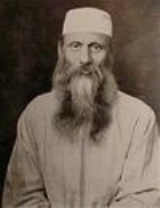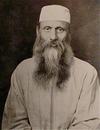
Bhagwan Das
Encyclopedia

India
India , officially the Republic of India , is a country in South Asia. It is the seventh-largest country by geographical area, the second-most populous country with over 1.2 billion people, and the most populous democracy in the world...
n theosophist and public figure. For a time he served in the Central Legislative Assembly
Central Legislative Assembly
The Central Legislative Assembly was a legislature for India created by the Government of India Act 1919 from the former Imperial Legislative Council, implementing the Montagu-Chelmsford Reforms...
of British India. He became allied with the Hindustani Culture Society and was active in opposing riot
Riot
A riot is a form of civil disorder characterized often by what is thought of as disorganized groups lashing out in a sudden and intense rash of violence against authority, property or people. While individuals may attempt to lead or control a riot, riots are thought to be typically chaotic and...
ing as a form of protest. As an advocate for national freedom from the British rule, he was often in danger of reprisals from the Colonial government.
Life
Born in VaranasiVaranasi
-Etymology:The name Varanasi has its origin possibly from the names of the two rivers Varuna and Assi, for the old city lies in the north shores of the Ganga bounded by its two tributaries, the Varuna and the Asi, with the Ganges being to its south...
, India, he graduated school to became a deputy in the collections bureau, and later left to continue his academic pursuits. Das joined the Theosophical Society
Theosophical Society
The Theosophical Society is an organization formed in 1875 to advance the spiritual principles and search for Truth known as Theosophy. The original organization, after splits and realignments has several successors...
in 1894 inspired by a speech by Annie Besant
Annie Besant
Annie Besant was a prominent British Theosophist, women's rights activist, writer and orator and supporter of Irish and Indian self rule.She was married at 19 to Frank Besant but separated from him over religious differences. She then became a prominent speaker for the National Secular Society ...
. After the 1895 split, he sided with the Theosophical Society Adyar
Theosophical Society Adyar
The Theosophy Society - Adyar is the name of a section of the Theosophical Society founded by Helena Petrovna Blavatsky and others in 1875. Its headquarters moved with Blavatsky and president Henry Steel Olcott to Adyar, an area of Chennai in 1883...
. Within that society, he was an opponent of Jiddu Krishnamurti
Jiddu Krishnamurti
Jiddu Krishnamurti or J. Krishnamurti or , was a renowned writer and speaker on philosophical and spiritual subjects. His subject matter included: psychological revolution, the nature of the mind, meditation, human relationships, and bringing about positive change in society...
and his "Order of the Star in the East
Order of the Star in the East
The Order of the Star in the East was an organization established by the leadership of the Theosophical Society at Adyar, India, from 1911 to 1927...
". Das joined the Indian National Congress
Indian National Congress
The Indian National Congress is one of the two major political parties in India, the other being the Bharatiya Janata Party. It is the largest and one of the oldest democratic political parties in the world. The party's modern liberal platform is largely considered center-left in the Indian...
during the Non-cooperation movement
Non-cooperation movement
The non-cooperation movement was a significant phase of the Indian struggle for freedom from British rule which lasted for years. This movement, which lasted from September 1920 to February 1922 and was led by Mohandas Gandhi, and supported by the Indian National Congress. It aimed to resist...
and was honoured with the Bharat Ratna
Bharat Ratna
Bharat Ratna is the Republic of India's highest civilian award, awarded for the highest degrees of national service. This service includes artistic, literary, and scientific achievements, as well as "recognition of public service of the highest order." Unlike knights, holders of the Bharat Ratna...
in 1955.
With Besant he formed a professional collaboration which led to the founding of the Central Hindu College
Central Hindu College
Central Hindu School, formerly known as Central Hindu College, is one of India's largest schools which is situated in the heart of the city at Kamachha Varanasi in India. This school provides the education to all societies of people having highly qualified faculties and aboratory and a SARGA HALL...
, which became Benaras Hindu University. Das would later found the Kashi Vidya Peeth, a national university where he served as headmaster. Das was a scholar of Sanskrit
Sanskrit
Sanskrit , is a historical Indo-Aryan language and the primary liturgical language of Hinduism, Jainism and Buddhism.Buddhism: besides Pali, see Buddhist Hybrid Sanskrit Today, it is listed as one of the 22 scheduled languages of India and is an official language of the state of Uttarakhand...
, from which he added to the body of Hindi language. He wrote approximately 30 books, many of these in Sanskrit and Hindi
Hindi
Standard Hindi, or more precisely Modern Standard Hindi, also known as Manak Hindi , High Hindi, Nagari Hindi, and Literary Hindi, is a standardized and sanskritized register of the Hindustani language derived from the Khariboli dialect of Delhi...
. Das received the Bharat Ratna
Bharat Ratna
Bharat Ratna is the Republic of India's highest civilian award, awarded for the highest degrees of national service. This service includes artistic, literary, and scientific achievements, as well as "recognition of public service of the highest order." Unlike knights, holders of the Bharat Ratna...
award in 1955.
He belonged to the prosperous and eccentric Shah family of Varanasi. He was excommunicated from the Agrawal Samaj for advocating that going across the sea does not cause one to lose his caste. The situation arose when his son Sri Prakasa
Sri Prakasa
Sri Prakasa was an Indian politician, freedom-fighter and administrator. He served as India's first High Commissioner to Pakistan from 1947 to 1949, Governor of Assam from 1949 to 1950, Governor of Madras from 1952 to 1956 and Governor of Bombay from 1956 to 1962.Sri Prakasa was born in Varanasi...
wanted to go to Britain to study law.
A prominent road in New Delhi
New Delhi
New Delhi is the capital city of India. It serves as the centre of the Government of India and the Government of the National Capital Territory of Delhi. New Delhi is situated within the metropolis of Delhi. It is one of the nine districts of Delhi Union Territory. The total area of the city is...
is named after him and a colony is also named after his name in Sigra area of Varanasi 'Dr. Bhagwan Das Nagar.'
Works
- A concordance dictionary to The yoga-sutras of Patanjali. Kaashai, Benares 1938.
- A few Truths about Theosophy. in The TheosophistThe TheosophistThe Theosophist is a theosophical journal. It was founded in 1879 by Helena Blavatsky, who was also its editor, and is still being published. The journal features articles about philosophy, art, literature and occultism.- External links :...
, Adyar September 1889. http://www.theosophical.ca/FewTruthsAboutTheosophyBD.html - Ancient solutions of modern problems. Theosophical Publishing House, Adyar 1933.
- Ancient versus modern "scientific socialism", or, Theosophy and capitalism, fascism, communism. Theosophical Publishing House, Adyar 1934. http://dli.iiit.ac.in/cgi-bin/Browse/scripts/use_scripts/advnew/metainfo.cgi?&barcode=5010010000280
- Annie Besant and the changing world. Theosophical Publishing House, Adyar 1934.
- Communalism and its cure by theosophy, Or spiritual health, the only sure basis of material wealth. Theosophical Publishing House, Adyar 1934. http://www.theosophical.ca/CommunalismBD.html
- Eugenics, Ethics and Metaphysics. Theosophical Publishing House, Adyar 1930. http://www.theosophical.ca/EugenicsEthicsandBD.htm
- Indian ideals of women's education. Current Thought Press, Madras 1929. http://www.theosophical.ca/IndianIdealsWomensEducationBD.html
- Krishna, a study in the theory of Avataras. Theosophical Publishing House, Adyar 1924.
- My picture of free India. Indian Book Shop, Benares et al. 1944. http://dli.iiit.ac.in/cgi-bin/Browse/scripts/use_scripts/advnew/metainfo.cgi?&barcode=5010010007246
- The central Hindu college and Mrs. Besant, the rise of the Alcyone cult. Divine Life Press, London 1913. http://www.parascience.org/hinducol.htm
- The dawn of another Renaissance. Theosophical Publishing House, Adyar 1931. http://www.theosophical.ca/DawnAnotherRenaissanceBD.html
- The essential Unity of all Religions. Theosophical Press, Wheaton 1939. http://dli.iiit.ac.in/cgi-bin/Browse/scripts/use_scripts/advnew/metainfo.cgi?&barcode=15074
- The Ethico-Psychological Crux in Political Science and Art, or, Who Should be Legislators?. Theosophical Publishing House, Adyar 1931. http://www.theosophical.ca/Ethico-PsychologicalBD.htm
- The fundamental idea of theosophy. Theosophist Office, Madras 1912. http://www.theosophical.ca/FundamentalIdea%20.htm
- The metaphysics and psychology of Theosophy. in The TheosophistThe TheosophistThe Theosophist is a theosophical journal. It was founded in 1879 by Helena Blavatsky, who was also its editor, and is still being published. The journal features articles about philosophy, art, literature and occultism.- External links :...
, Adyar 1916. http://www.theosophical.ca/MetaphysicPsychologyP1.html und http://www.theosophical.ca/MetaphysicPsychologyP2.html - The philosophy of non-co-operation and of spiritual-political swaraj. Tagore & Co., Madras 1922.
- The psychology of conversion. Theosophical Publishing House, Adyar 1917. http://www.theosophical.ca/PsychologyOfConversionBD.htm
- The religion of theosophy. Theosophist Office, Madras 1911. http://www.theosophical.ca/ReligionOfTheosophyBD.htm
- The science of peace, an attempt at an exposition of the first principles of the science of the self. Theosophical Publishing House, Benares et al. 1904. http://dli.iiit.ac.in/cgi-bin/Browse/scripts/use_scripts/advnew/metainfo.cgi?&barcode=2030020003259
- The science of religion, or, Sanatana vaidika dharma, an attempt at an exposition of principles. Indian Book Shop, Benares 1948.
- The Science Of Social Organization, or, The Laws Of Manu In The Light Of Atma Vidya. Theosophical Publishing House, Adyar 1935. http://dli.iiit.ac.in/cgi-bin/Browse/scripts/use_scripts/advnew/metainfo.cgi?&barcode=150259
- The science of social organisation, or, The laws of Manu in the light of Theosophy. Theosophist Office, Adyar 1910. http://dli.iiit.ac.in/cgi-bin/Browse/scripts/use_scripts/advnew/metainfo.cgi?&barcode=5010010008485
- The science of the emotions. Theosophical Publishing House, Benares et al. 1908. http://www.archive.org/details/scienceoftheemot024532mbp
- The spiritualisation of the science of politics by Brahma-vidya. Theosophical Publishing House, Adyar 1919.
- The superphysics of the Great War. Theosophical Publishing House, Adyar 1916.
Literature
- Katherine Browning: An epitome of the "science of the emotions", a summary of the work of Pandit Bhagavan Das. Theosophical Publishing House, London 1925.
External links
- short biography (indianpost.com)

